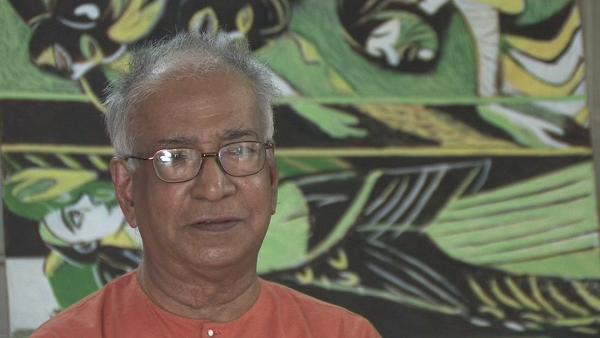NEXT STORY

The Bengali revival
RELATED STORIES

NEXT STORY

The Bengali revival
RELATED STORIES


|
Views | Duration | |
|---|---|---|---|
| 51. Hybrid art | 49 | 04:48 | |
| 52. Stella Kramrisch | 276 | 02:17 | |
| 53. Leaving Baroda in 1980 – I was becoming like a mother hen | 35 | 09:37 | |
| 54. My studio and extended family in Baroda | 53 | 02:45 | |
| 55. Santiniketan in the 1980s and the freedom to work | 43 | 01:40 | |
| 56. Where I am today | 43 | 01:37 | |
| 57. My book of essays Moving Focus | 111 | 05:00 | |
| 58. The Bengali revival | 53 | 03:47 | |
| 59. The Kolkata University lectures | 1 | 49 | 02:40 |
| 60. Changes in the art world – effects of the... | 1 | 66 | 07:10 |


Those essays were written on different occasions and they cover a large area of time. The only thing, it was addressed to audiences who were quite unaware of like for instance Abindranath and this sort of thing. In fact, particular, I mean apart from the other essays, the Abindranath essay was done for his centenary seminar, which I couldn’t attend, and I had gone to Santiniketan on a visit at that time, and they approached me with the kind of request. So I said how can I write about Abindranath when I haven’t seen anything of this work? I had seen a few things which were around in Santiniketan, but there were very few. There was a large area of work which I had learnt from a kind of a listing done by Benode Bihari in one of the Visva Bharati Quarterly numbers, and I haven’t seen all this. Then I discovered that it was in the hands of the Rabindr Bharati Society. The background of it as I understand it is like this, that when in his later years Abindranath went bankrupt, the whole family couldn’t sort of pay back their debts, so their part of the building in Dwarakanath Tagore Lane was sold off to somebody. They sold all his paintings, and finally he moved to a small house in the outskirts.
Of Kolkata?
Of Kolkata, and of course he sat there and read some delightful things there. I mean, he sort of wrote, and one of them is his experience of moving and all the revelries around. Now, this man, when this happened, when certain part of the Kolkata public thought that this was such a shame, so they raised some money and bought back that thing and put in this sort of Society, and it is in the sort of safekeeping of the Society, if you call that safekeeping. They have about, I mean, works of Abu Nindranath and certain, and the larger collection of the works of other people of that time, about I think more than 2,500 works all locked in three trunks. There are only two rooms where they keep these things, and it is presided over by one secretary who is always very unwilling to show it out to you. They have a chairman who is generally hardly there. He only comes for the meetings. So when I wanted to look, I went to see it, luckily the vice chancellor of that time who is a known historian called Partul Gupta, he said I can arrange it, because he was on the committee and he had some say in the matter. So, before coming to Baroda I stopped by for 2 days in Kolkata and had a look at it. Then I found this fabulous treasure trove. I mean, there were about 600 works of Abu Abindranath out of which this Arabian Nights series were the cream of the whole lot, and it was done as recorded. In the course of 1 year, 40 paintings of big size, it was done in the course of 1 year, almost at the same time when he was delivering what I call the Vageswari Lectures in Art.
Was that in the 1930s?
Huh?
In the ’30s?
No, it ended in 1929 or ’30, but it started much earlier, the Vageswari Lectures, probably from ’26 to ’30 or something of that kind. Now, I mean that was really an eye opener. I had never seen anything like it before. So that is why I wrote that essay. The other thing that had come there is of course on the basis of a lecture here or a lecture there and things of that kind, and the art and change thing was delivered in Santiniketan again when I went from here on an extension lecture, or visiting professorship. So it was all brought together by Sheikh, and now here it has gone into a new edition.
KG Subramanyan (1924-2016) was an Indian artist. A graduate of the renowned art college of Kala Bhavana in Santiniketan, Subramanyan was both a theoretician and an art historian whose writings formed the basis for the study of contemporary Indian art. His own work, which broke down the barrier between artist and artisan, was executed in a wide range of media and drew upon myth and tradition for its inspiration.
Title: My book of essays Moving Focus
Listeners: Timothy Hyman
Timothy Hyman is a graduate of Slade School of Fine Art, London, in which he has also taught. In 1980 and 1982, he was Visiting Professor in Baroda, India. Timothy Hyman has curated many significant art exhibitions and has published articles and monographs on both European and Indian artists.
Duration: 5 minutes, 1 second
Date story recorded: 2008
Date story went live: 10 September 2010